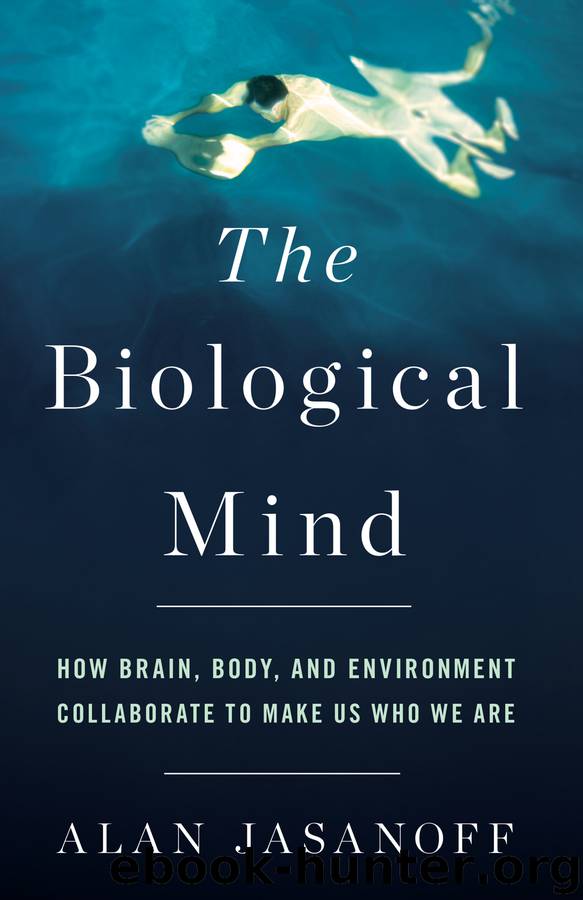The Biological Mind by Alan Jasanoff

Author:Alan Jasanoff
Language: eng
Format: epub, azw3
Publisher: Basic Books
Published: 2018-03-13T04:00:00+00:00
We have now seen how the cognitive revolution and the rise of neuroscience carried the brain to its central place as an explanatory factor in our lives. The neuroessentialist attitude that our key characteristics are determined by our brains reflects the continuing backlash against behaviorism and its emphasis on the environment. Like behaviorism, however, the modern brain-centered perspective often fails to produce an integrated picture of how internal and external factors combine to guide human activity. Instead, it encourages a focus on the role of the brain to the exclusion of other factors that influence what people think and do. We can appreciate this most clearly by considering a specific example of neuroessentialism in action.
The world’s most notorious icon of neuroessentialism spent its golden years steeping placidly in a jar of formaldehyde, secluded from civilization in a brain bank at the University of Texas at Austin. The specimen’s peaceful retirement belied a violent past, however; this past was stamped indelibly into its stripes of gray and white matter like stains and creases on an old piece of newspaper. For a start, the famous brain was far from intact. Soon after the organ had been extracted from its natural habitat, a pathologist’s knife sliced it into fillets, unkindly exposing its inner structures for an autopsy. Many of the cuts revealed gross disfigurations. The left frontal and temporal lobes, once seats of cognitive and sensory prowess behind the eye and ear, were brutally lacerated. Shards of bone had sheared across the tissue, forced through by the impact of hot lead bullets on the once protective skull. In another part of the brain, near a pinkish blotch called the red nucleus, the tissue had been pried apart by another kind of bullet—a malignant tumor the size of a walnut that would have meant certain death to its bearer, had metal projectiles not arrived first. The story of this tumor and the organ that harbored it illustrates how the problem of reconciling the agencies that act inside versus outside the individual remains unresolved even now.
The forlorn brain’s original owner, a former marine and trained sniper named Charles Whitman, had committed one of the worst mass murders in American history. In the early hours of August 1, 1966, he stabbed his mother and his wife to death. Later in the morning, he transported a small arsenal of weaponry to the top of the 307-foot Main Building on the UT Austin campus and unleashed a fusillade that killed or wounded forty-eight people in and around the tower. Two hours into the rampage, Whitman was finally cornered by Austin police and felled by two blasts from Officer Houston McCoy’s shotgun. To the public, not accustomed to outbreaks of military-style violence in civilian settings, the massacre was deeply unsettling. “In many ways Whitman forced America to face the truth about murder and how vulnerable the public could be in a free and open society,” writes author Gary Levergne in his book A Sniper in the Tower.
But it was Whitman’s brain that soon claimed center stage.
Download
This site does not store any files on its server. We only index and link to content provided by other sites. Please contact the content providers to delete copyright contents if any and email us, we'll remove relevant links or contents immediately.
| Administration & Medicine Economics | Allied Health Professions |
| Basic Sciences | Dentistry |
| History | Medical Informatics |
| Medicine | Nursing |
| Pharmacology | Psychology |
| Research | Veterinary Medicine |
The Art of Thinking Clearly by Rolf Dobelli(10142)
The 5 Love Languages: The Secret to Love That Lasts by Gary Chapman(9518)
Mindhunter: Inside the FBI's Elite Serial Crime Unit by John E. Douglas & Mark Olshaker(9103)
Becoming Supernatural by Dr. Joe Dispenza(8039)
The Road Less Traveled by M. Scott Peck(7474)
Nudge - Improving Decisions about Health, Wealth, and Happiness by Thaler Sunstein(7460)
Mastermind: How to Think Like Sherlock Holmes by Maria Konnikova(7164)
Enlightenment Now: The Case for Reason, Science, Humanism, and Progress by Steven Pinker(7084)
Win Bigly by Scott Adams(7032)
The Way of Zen by Alan W. Watts(6451)
Factfulness: Ten Reasons We're Wrong About the World – and Why Things Are Better Than You Think by Hans Rosling(4628)
The State of Affairs by Esther Perel(4588)
Gerald's Game by Stephen King(4513)
Man's Search for Meaning by Viktor Frankl(4357)
The Confidence Code by Katty Kay(4158)
Thinking in Bets by Annie Duke(4121)
Hidden Persuasion: 33 psychological influence techniques in advertising by Marc Andrews & Matthijs van Leeuwen & Rick van Baaren(3416)
The Healing Self by Deepak Chopra(3405)
The Worm at the Core by Sheldon Solomon(3397)
